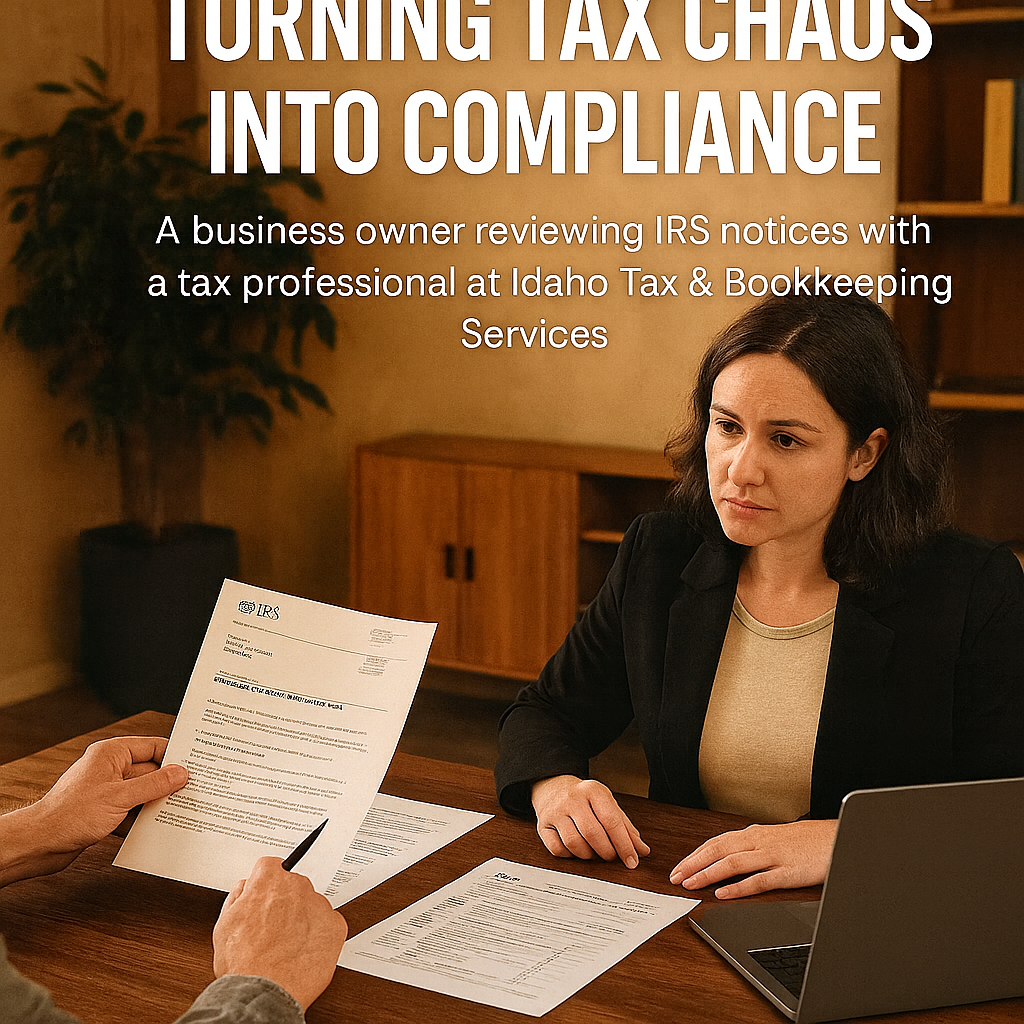Every January, millions of taxpayers and small business owners start the new year with the same resolution: get right with the IRS.
Yet for many, the cycle of unfiled returns, ignored notices, and mounting penalties continues. The reason is not always irresponsibility. It is often overwhelm. The U.S. tax system is complex, notices are confusing, and penalties accumulate quietly until they become unmanageable.
If you have ever felt that you are one step behind on taxes, this guide is for you. It shows how to turn financial chaos into compliance and peace of mind before another year slips by.
The Truth About IRS Debt
IRS debt does not happen overnight. It builds slowly from a missed filing, a payroll error, an unexpected bill after a business loss, or not understanding how self-employment taxes work.
Here is the truth. The IRS rarely forgets. Balances grow with interest and penalties that can double the original debt within a few years. Even worse, the IRS has the power to levy bank accounts, garnish wages, and seize refunds without a court order.
The hopeful truth is that the IRS is more flexible than most people realize. With proper documentation and professional guidance, many taxpayers qualify for relief, including payment plans, penalty abatements, or full debt settlements through an Offer in Compromise (OIC).
The first step to freedom is understanding why the debt exists and how the IRS classifies it.
Identifying the Source of Your Tax Trouble
Before any resolution strategy can work, you must know exactly what the IRS believes you owe.
Start by obtaining your IRS Account Transcript for each year in question. You can do this online through the IRS website or by filing Form 4506-T.
Look for:
- Return Filed Date which confirms whether a return is on record.
- Tax Assessed which shows when and how much tax was calculated.
- Payments and Credits which verify what has been applied.
- Penalty and Interest Transactions which show how fast the balance is growing.
If you notice missing years or inconsistent data, that is your starting point. Unfiled returns are the biggest barrier to any resolution because the IRS will not negotiate until all required filings are complete.
At Idaho Tax and Bookkeeping Services, we often see clients who owe less than they think. Sometimes the IRS files a Substitute for Return (SFR), an automated estimate based on W-2s and 1099s that overstates income and ignores deductions. Replacing those SFRs with correct returns can reduce debt dramatically.
How to Regain Control Before the New Year
December is the best time to act because interest and penalties continue into the new year, and IRS collection cycles restart in January.
Here is a year-end action plan to move from chaos to compliance.
Step 1: File All Missing Returns
Even if you cannot pay, filing stops failure-to-file penalties and starts the statute of limitations clock.
If records are missing, request wage and income transcripts from the IRS. They contain every W-2, 1099, and mortgage report under your Social Security number.
Step 2: Review Withholding and Estimated Payments
Check your 2025 income so far. If you are underpaying, make a catch-up estimated payment before January 15. For small businesses, review payroll tax deposits since trust fund recovery penalties can apply personally to owners.
Step 3: Organize Your IRS Notices
Group letters by tax year and notice type such as CP14, CP2000, or LT11. Many taxpayers panic and mix them up which delays help. When we handle resolution cases, our first move is building a clear timeline of IRS correspondence.
Step 4: Choose the Right Resolution Strategy
Not every case fits the same mold. The IRS offers several programs, each designed for specific circumstances.
| Program | Best For | Key Advantage |
| Installment Agreement (IA) | Steady income, can afford monthly payments | Stops collection activity |
| Partial Payment IA | Limited income, cannot pay full balance | Pay what you can afford |
| Offer in Compromise (OIC) | Income or asset limitations, hardship | Settle for less than full amount |
| Currently Not Collectible (CNC) | Low income, hardship status | Temporary suspension of collections |
| Penalty Abatement | Reasonable cause such as illness, disaster, or reliance on a professional | Removes or reduces penalties |
Each program has its documentation requirements, but all start with one rule: compliance first.
Understanding Penalties and How to Remove Them
Most people think the IRS is unforgiving, but it operates under rules that can work in your favor.
Common Penalties
- Failure to File: 5 percent per month, up to 25 percent.
- Failure to Pay: 0.5 percent per month, up to 25 percent.
- Accuracy-Related: 20 percent of understated tax.
- Estimated Tax Penalty: Based on underpayment percentage.
Penalty Relief Options
- First-Time Abatement (FTA): For taxpayers with a clean history, no penalties in prior three years.
- Reasonable Cause: Based on documented hardship such as illness, disaster, or unavoidable absence.
- Administrative Waiver: Granted when the IRS recognizes systemic errors or policy changes.
At our office, we build detailed reasonable-cause narratives with supporting evidence such as hospital records, death certificates, or correspondence showing diligence. The IRS grants abatement when the human story supports the numbers.
The Emotional Cost of IRS Debt
Behind every case number is a story.
A retired couple who lost records after a house fire.
A contractor who fell behind on quarterly payments after a slow season.
A single mother whose prior preparer filed incorrectly.
IRS debt creates constant anxiety, fear of mail, and credit strain. The emotional toll often exceeds the financial one.
The turning point comes when people stop avoiding the issue and face it directly. Once you know what you owe, you regain control. The IRS becomes a process, not a threat.
Why Professional Help Matters
You can negotiate with the IRS directly, but having a licensed representative such as a CPA, EA, or attorney increases success rates. Professionals understand how the IRS evaluates cases, what documentation carries weight, and when to escalate to Appeals.
Professional representation provides:
- Transcript analysis to reconstruct your IRS record accurately.
- Compliance restoration to ensure all filings are current.
- Financial statement preparation for OIC or hardship cases.
- Direct IRS communication so you avoid stressful calls.
- Strategic timing that can save thousands.
At Idaho Tax and Bookkeeping Services, we often say that resolution is not about fighting the IRS but about speaking their language fluently.Setting Up for a Clean 2026
Once your tax issues are resolved, keeping them under control becomes easier.
Here are five steps to keep 2026 compliant.
- Automate estimated tax payments using EFTPS or IRS Direct Pay.
- Review your entity structure. An LLC taxed as an S Corporation can reduce self-employment taxes if income justifies it.
- Maintain digital records by scanning receipts, mileage logs, and invoices monthly.
- Run quarterly check-ins with your CPA. Small adjustments prevent big surprises.
- Keep a resolution emergency folder with IRS transcripts, prior returns, and notices for quick access.
- The Power of the Fresh Start Program
The IRS Fresh Start Initiative remains one of the most underused relief options.
It was created to help taxpayers recover from economic hardship and still applies today.
Key benefits:
- Higher debt threshold for streamlined installment agreements up to $50,000.
- Fewer documentation requirements for wage earners and small businesses under certain limits.
- Suspension of liens during negotiation if the taxpayer cooperates.
We have helped clients settle balances for a fraction of the amount owed through Offers in Compromise or structured payment plans. The key is acting before enforcement begins.
-
What Happens If You Do Nothing
Procrastination has a price.
If you ignore IRS debt:
- Interest continues daily.
- Penalties compound monthly.
- Refunds are intercepted.
- Liens attach to property and credit.
- Levies can reach bank accounts or wages.
Once the IRS assigns a Revenue Officer, options narrow quickly. Acting early, even in November or December, gives you leverage and protects your assets before enforcement begins.
-
A Mindset Shift: From Fear to Clarity
Tax problems often bring shame. People feel judged, even by themselves. But every resolution story begins with acceptance: It happened. Now we fix it.
The moment you face your IRS debt directly, it loses control over you. Whether it is five thousand or five hundred thousand, every balance follows a formula, and every formula has a solution.
Compliance is not only about numbers. It is about rebuilding confidence, stability, and the ability to move forward without fear of the next IRS envelope.
Conclusion: Your Next Step Toward Freedom
The path from chaos to compliance starts with one conversation.
Whether you need to file missing returns, reduce penalties, or negotiate a payment plan, the key is timing, and now is the time.
At Idaho Tax and Bookkeeping Services, we have helped many individuals and businesses rebuild after IRS debt. Our approach is simple:
- Diagnose the problem through full IRS transcript review.
- Restore compliance by filing or correcting returns.
- Negotiate the best resolution quickly and respectfully.
Start the new year with peace of mind, not penalties.
Schedule your confidential consultation today and turn your tax story into one of resolution and renewal.



